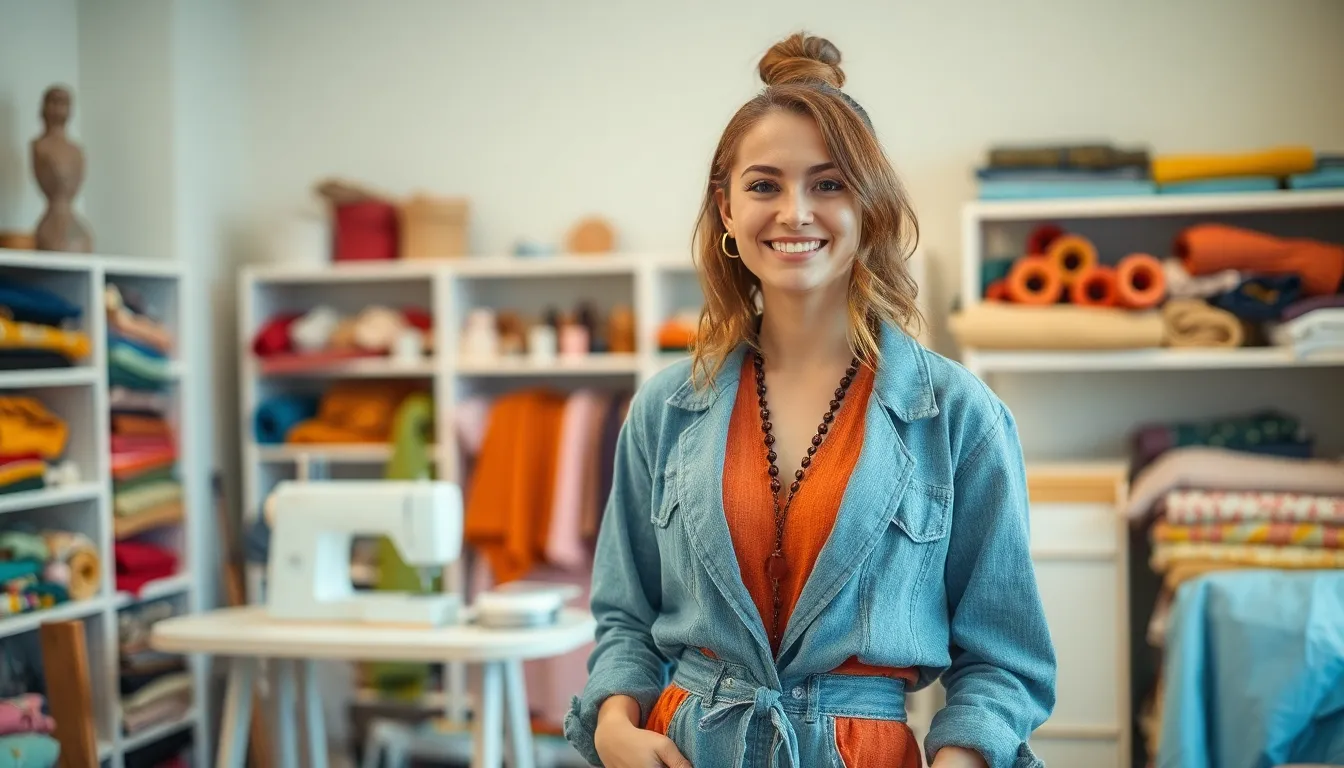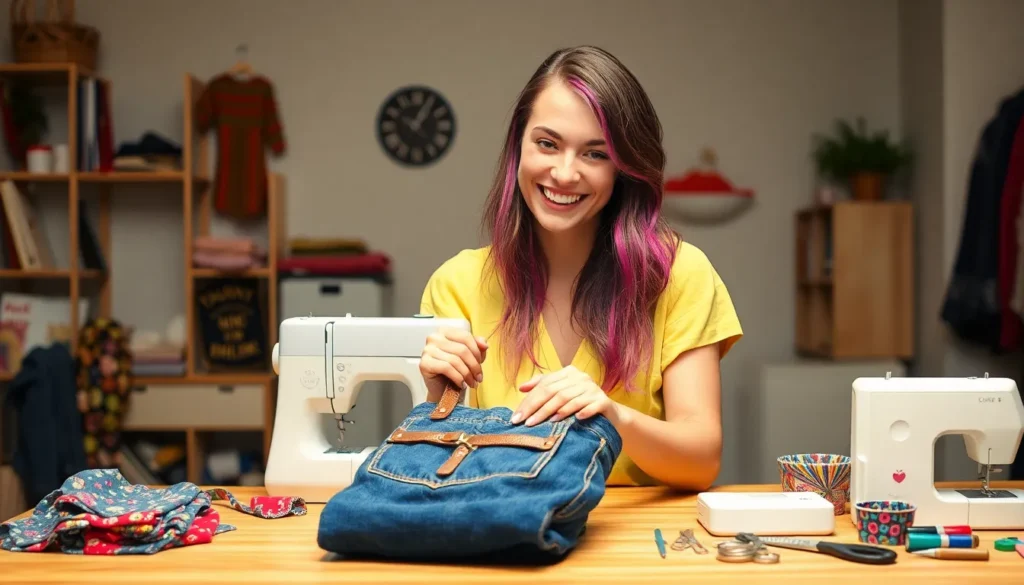In a world where fast fashion dominates, DIY fashion emerges as a refreshing alternative. It empowers individuals to express their unique style while promoting sustainability and creativity. With a little imagination and some basic skills, anyone can transform old garments into trendy pieces, making fashion personal and eco-friendly.
DIY fashion isn’t just about saving money; it’s about embracing individuality. From upcycling vintage finds to creating custom accessories, the possibilities are endless. People are discovering the joy of crafting their wardrobe, and in the process, they’re building a community of like-minded creators. Whether you’re a seasoned crafter or a curious beginner, diving into DIY fashion can unlock a world of self-expression and innovation.
Table of Contents
ToggleWhat Is DIY Fashion?
DIY fashion stands for “do it yourself” fashion, encompassing the practice of creating, altering, or customizing clothing and accessories. Individuals use various techniques like sewing, upcycling, or embellishing to design unique apparel that reflects their personal style. DIY fashion emphasizes sustainability by encouraging the reuse of existing materials, reducing waste, and minimizing the carbon footprint associated with mass production.
Crafters engage in DIY fashion as a way to develop creativity while saving money. For example, they might transform an old denim jacket with patches or turn a vintage dress into a modern skirt. This hands-on approach fosters a strong sense of accomplishment and community among participants, whether they are experienced makers or novices.
DIY fashion also focuses on individuality. Each piece created holds a story and embodies the creator’s vision, making it distinct from mass-produced items. Creative explorations in DIY fashion often lead to innovative designs and trends, further enhancing the uniqueness of each piece. As a movement, DIY fashion inspires individuals to break away from conventional styles and express themselves authentically.
Benefits of DIY Fashion

DIY fashion offers numerous advantages, including cost savings and unique personal expression. This trend not only enhances creativity but also encourages individuals to embrace sustainable practices.
Cost-Effective Solutions
DIY fashion provides significant savings compared to purchasing new clothing. Individuals can repurpose old garments, reducing the need for new materials. For example, transforming thrift store finds into fashionable outfits can cost less than $30, whereas new pieces often exceed $100. By utilizing existing resources, individuals minimize expenses and help the environment by lowering waste.
Personalized Style
DIY fashion fosters a distinctive sense of style. Each piece made reflects the individual’s taste, allowing for complete customization. Individuals can design clothing that suits their body types, preferences, and lifestyle. For instance, altering a simple dress with unique embellishments or dyeing a shirt in a preferred color results in items that stand out in a crowd. This personal touch leads to a wardrobe that isn’t just functional but also represents the wearer’s identity.
Essential Tools and Materials
DIY fashion requires specific tools and materials to facilitate creativity and ensure successful projects. Having the right supplies on hand simplifies the crafting process and enhances the final product quality.
Basic Sewing Supplies
Basic sewing supplies form the foundation of any DIY fashion project. Essential items include:
- Sewing Machine: A reliable machine streamlines stitching tasks, making them quicker and more precise.
- Needles: Use universal or specialized needles for different fabrics; keep a variety on hand for versatility.
- Thread: Select high-quality thread that matches the fabric; polyester and cotton options work best.
- Fabric Scissors: Sharp scissors designed exclusively for fabric ensure clean cuts and minimize fraying.
- Measuring Tape: Accurate measurements prevent fitting issues; a retractable tape is compact and easy to store.
- Pins and Clips: Use pins to hold fabric layers together and clips for thicker materials; both prevent shifting while sewing.
- Seam Ripper: This tool simplifies the removal of seams, allowing for easy adjustments when mistakes occur.
Additional Crafting Tools
Additional crafting tools enhance creativity and expand project possibilities. Consider incorporating:
- Iron: Pressing fabric smooths wrinkles and sets seams, improving overall appearance and construction.
- Cutting Mat: A self-healing mat provides a safe surface for cutting fabric, protecting workspaces from damage.
- Rotary Cutter: This tool cuts fabric quickly and accurately, ideal for straight lines and intricate patterns.
- Embroidery Floss: Use colorful floss for decorative hand-stitching, adding personal touches to garments.
- Dye and Paint: Fabric dyes and paints offer opportunities for color customization, elevating old fabrics into fresh designs.
- Fabric Glue: Ideal for quick fixes and embellishments, fabric glue adheres without sewing, suitable for embellishing projects.
Equipping with these essential tools and materials sets the stage for a successful DIY fashion journey.
Popular DIY Fashion Projects
DIY fashion offers a variety of exciting projects that allow for creativity and sustainability. Below are some popular DIY fashion projects that many creators enjoy.
Upcycling Old Clothes
Upcycling old clothes transforms worn or outdated garments into fresh, stylish pieces. Individuals often cut, sew, or dye clothing items to give them new life. Common techniques include patchwork, which introduces fabric scraps for added texture, and distressing, which creates a trendy, vintage look. According to a report from Fashion Revolution, upcycling significantly reduces textile waste, making it an eco-friendly choice. Many creators showcase their unique designs on platforms like Instagram or Pinterest, fostering a strong community around the upcycled fashion movement.
Custom Accessories
Custom accessories add a personalized touch to any outfit. From embellished bags to unique jewelry, individuals create accessories that reflect their personal style. Popular projects include beaded necklaces, fabric headbands, and hand-painted tote bags. Custom accessories often use inexpensive or repurposed materials, making them budget-friendly. A study by the Sustainable Apparel Coalition indicates that accessory customization not only enhances creativity but also promotes a sense of ownership over personal fashion. Many DIY enthusiasts share tutorials online, inspiring others to craft their own distinctive accessories.
Tips for Successful DIY Fashion
Successful DIY fashion projects combine inspiration, techniques, and creativity. These tips help individuals maximize their DIY journeys while ensuring both satisfaction and sustainability.
Finding Inspiration
Finding inspiration is crucial in the DIY fashion process. Check various sources, including fashion blogs, social media platforms like Instagram and Pinterest, and local thrift stores. Researching current trends and vintage styles helps spark ideas. Attending craft fairs or clothing swap events fosters connections with fellow DIY enthusiasts. Collect visual references in a scrapbook or digital folder to maintain a focused direction for upcoming projects.
Techniques for Beginners
Beginners can benefit from mastering fundamental techniques in DIY fashion. Start with basic sewing skills such as straight stitching, hemming, and attaching buttons. Learn fabric manipulation techniques like gathering, pleating, or applique to enhance designs. Experiment with upcycling methods, which involve transforming old garments through cutting or adding embellishments. Protecting fabrics with proper care, such as washing and ironing, ensures longevity. With practice and patience, beginners can gradually tackle more complex projects, boosting their skills and confidence.
DIY fashion offers a vibrant and sustainable way for individuals to express their unique style while reducing their environmental impact. By embracing creativity and resourcefulness, anyone can transform old garments into fashionable statements that reflect their personality. This movement not only promotes personal expression but also fosters a supportive community of crafters who inspire one another.
With the right tools and a willingness to experiment, anyone can embark on a fulfilling DIY fashion journey. The possibilities are endless, and each project can lead to new skills and innovative designs. As more people join this movement, they contribute to a shift away from fast fashion, making a positive impact on both their wardrobes and the planet.




